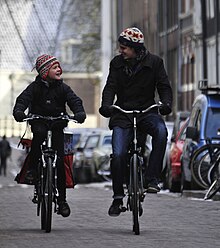Cycling in the Netherlands
[7] Cycling became popular in the Netherlands a little later than it did in the United States and Britain, which experienced their bike booms in the 1880s, but by the 1890s the Dutch were already building dedicated paths for cyclists.
Then, much like it had in other developed nations, the privately owned motor car became more affordable and therefore more commonly in use and bicycles as a result less popular.
[8] The trend away from the bicycle and towards motorised transport only began to decrease in the 1970s when Dutch people took to the streets to protest against the high number of child deaths on the roads: in some years over 500 children were killed in collisions with motor vehicles.
[10] [13] The success of this movement—along with other factors, such as the oil shortages of 1973–74[14] and the publication of the CROW Design Manual for Bicycle Traffic—turned government policy around.
The country began to restrict urban motor vehicle use and direct its focus on growth towards other forms of transport, with the bicycle perceived as critical in making streets safer and towns and cities more people-friendly and livable.
In Amsterdam alone, 490,000 cyclists took to the road to cycle 2 million kilometres every day, according to its city council statistics.
This is being addressed by building even more bike lanes to tackle a problem many other cities in the world would envy—that of bicycle traffic congestion.
When enough space is available, larger roads are fitted with a parallel fietspad (bike path) that is physically separated—for example by means of a verge, hedge, or parking lane—from the roadway.
When the maximum speed is 45 km/h (yellow license plate), mopeds are only allowed to use the cycle paths if that is indicated (mostly outside of the built-up area).
Motorists are not allowed on bike paths, and to enforce this the entry of cars is often made physically impossible by using obstacles.
The red colour has no legal meaning, it is there for visibility; the on-road bike lane is delineated by the solid or dashed line by which it is separated from the roadway.
A fietsstraat (cycle street)[38] is a road where bicycles are considered to be the primary and preferred form of transport and where cars and other motorised vehicles are allowed "as guests".
[40][41] For instance, many Dutch towns and cities have a "soft" green core that is only accessible to cyclists and pedestrians.
On a small scale, short sections of cycle path can provide a short cut between streets that cars cannot take, while on a larger scale entire streets are sometimes converted to cycle paths to provide more room for cyclists and discourage the use of motorized vehicles.
If the available space is too limited even for a cycle lane, for example when a road passes through a village, speed-reducing measures are usually taken to ensure that the difference in speed between cyclists and motorists is tolerable.
[43] Cycling interest groups and national and local governments advocate such routes as being a solution for the further reduction of vehicular traffic congestion: this is because, as cyclists can achieve higher average speeds on these routes than on the usual types of cycling infrastructure, so cyclists are better able to compete with the car for longer commutes on them.
As of 2012[update], cycle highways currently being constructed include one between Rotterdam and Delft, and one between Nijmegen and Arnhem (the RijnWaalpad).
Most fast-cycling routes/cycle highway projects are not entirely purpose-built, but consist of upgrading existing infrastructure and adding missing links between them.
Opening on 29 June 2012, it is an elevated circular suspension bridge and bicycle-only roundabout built in between the localities of Eindhoven, Veldhoven and Meerhoven (thus the name, being Dutch for "Ring of the 'Hovens'") in the province of North Brabant.
The small waterways such as canals, which abound especially throughout western Holland, will often have dedicated bridges for cyclists or ones that they share with pedestrians.
However, to cross large waterways, cycle paths are often situated alongside roads (for instance the Hollandse Brug) or sometimes railroads (for example the Nijmegen railway bridge).
In many locations more direct cycle routes exist which bypass traffic signals, allowing cyclists to make more efficient journeys than motorists.
Occasionally, cyclists are explicitly allowed to pass a red traffic light if they make a right turn on an intersection.
[46] Signposts take on the form of road signs, with directions stating the distances to nearby cities and towns.
Since the start of the 21st century, parking spaces for 450,000 bicycles were built and modernized at over 400 train stations, and Dutch railways organizations ProRail and NS are calling for expansion by another 250,000 by 2027.
[citation needed] Cyclist journeys are made more convenient by such actions as it prevents sidewalks being littered with bikes.
A national scheme, Cycleswap, supports small businesses privately renting bicycles out for short-term use.
Almost 15,000 OV-fietsen[55] are offered for rent at over 300 locations across the Netherlands; at many train stations, at bus or tram stops, in several city centres and at P+R car parks.
[62] Swapfiets is a bike rental service for residents of several European countries that, for a fixed monthly price, provides a bicycle and covers all repair costs.
The service started as a startup that rented refurbished bikes but has since developed an in-house design featuring a distinctive blue front tire.
















